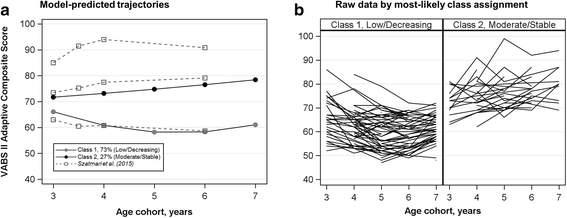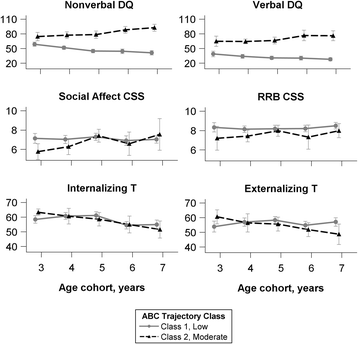Classifying and characterizing the development of adaptive behavior in a naturalistic longitudinal study of young children with autism
- PMID: 29329511
- PMCID: PMC5795287
- DOI: 10.1186/s11689-017-9222-9
Classifying and characterizing the development of adaptive behavior in a naturalistic longitudinal study of young children with autism
Abstract
Background: Adaptive behavior, or the ability to function independently in ones' environment, is a key phenotypic construct in autism spectrum disorder (ASD). Few studies of the development of adaptive behavior during preschool to school-age are available, though existing data demonstrate that the degree of ability and impairment associated with ASD, and how it manifests over time, is heterogeneous. Growth mixture models are a statistical technique that can help parse this heterogeneity in trajectories.
Methods: Data from an accelerated longitudinal natural history study (n = 105 children with ASD) were subjected to growth mixture model analysis. Children were assessed up to four times between the ages of 3 to 7.99 years.
Results: The best fitting model comprised two classes of trajectory on the Adaptive Behavior Composite score of the Vineland Adaptive Behavior Scale, Second Edition-a low and decreasing trajectory (73% of the sample) and a moderate and stable class (27%).
Conclusions: These results partially replicate the classes observed in a previous study of a similarly characterized sample, suggesting that developmental trajectory may indeed serve as a phenotype. Further, the ability to predict which trajectory a child is likely to follow will be useful in planning for clinical trials.
Keywords: Adaptive behavior; Autism spectrum disorders; Longitudinal studies.
Conflict of interest statement
Ethics approval and consent to participate
Informed consent was obtained for participants, who were enrolled in a longitudinal natural history study of autism approved by an NIH Institutional Review Board (06-M-0102).
Consent for publication
Not applicable.
Competing interests
The authors declare that they have no competing interests.
Publisher’s Note
Springer Nature remains neutral with regard to jurisdictional claims in published maps and institutional affiliations.
Figures


References
-
- American Psychiatric Association . Diagnostic and statistical manual of mental disorders (4th ed., text rev.) Washington, DC: Author; 2000.
-
- American Psychiatric Association . Diagnostic and statistical manual of mental disorders (5th ed.) Arlington: American Psychiatric Publishing; 2013.
-
- Dykens E, Lense M. Intellectual disabilities and autism spectrum disorder: a cautionary note. In: Amaral D, Geschwind D, Dawson G, editors. Autism spectrum disorders. Oxford: Oxford University Press; 2011. pp. 261–269.
Publication types
MeSH terms
Grants and funding
LinkOut - more resources
Full Text Sources
Other Literature Sources
Medical

